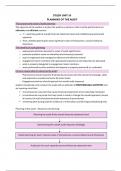STUDY UNIT 10
PLANNING OF THE AUDIT
The purpose and result of audit planning:
The objective of the auditor is to plan the audit as a whole so that it will be performed in an
e ective and e icient manner.
1st – planning audit at overall financial statement level and establishing overall audit
response
Then, detailed planning for each significant class of transaction, account balance,
disclosure.
The benefits of audit planning:
o appropriate attention devoted to areas of audit significance
o potential problem areas are identified and timeously resolved
o audit is organised and managed in e ective and e icient manner
o engagement team members with appropriate experience and expertise are allocated
o work is properly delegated to engagement team members
o work performed by other auditors and experts is properly planned & co-ordinated
Persons responsible for planning the audit:
Planned and overall response finalised by person(s) with the relevant knowledge, skills
and experience (usually someone @ senior level)
Engagement partner should approve the overall audit response
Auditor should plan and conduct the audit with an attitude of PROFESSIONAL SCEPTISM and
an inquiring mind that:
circumstances may exist that cause financial statements to be materially misstated
circumstances may arise that may result in need to change the overall approach (scope
& conduct of audit and planned audit responses & procedures)
remaining alert during audit for evidence or information (confirming/contradicting info)
Planning of the audit – Sequence of planning:
Planning the audit @ the overall financial statement level
Determining the overall audit response (strategy)
Detail planning for each material class of transactions, account balance and disclosure
Audit plan for each separate account/financial statement item
, 1. Planning the audit
Step 1 - obtaining an understanding of the entity and its environment and applicable
financial reporting framework:
Purpose:
to identify and assess the risk of material misstatements at the overall FS level
formulating an overall audit response
assigning sta of right experience, skills, competence
Internal factors
Organisational Complexity of the entity’s structure: Risk that subsidiaries are
structure & not correctly consolidated, and issues (e.g. goodwill,
ownership investments) not correctly accounted for or disclosed
ownership and relationships (e.g. related party transactions) not
correctly identified, accounted for and disclosed
structure and complexity of IT environment (e.g. risk that IT
systems may not be well integrated resulting in complex IT
environments)
Governance Understanding the structures and processes for over-sight of the
entity and its operations
Business model & Scope of activities and rationale thereof
strategy Structure & scale of operations
Markets or geographical spheres
Business and operating processes
Business activities Business operations (e.g. revenue sources, geographical
dispersion, key customers, etc.)
investment & investment activities (e.g. acquisitions, capital
investment, disposals, etc.)
financing & financing activities (e.g. group structures, debt
structure, leasing, etc.)
nature of Special purpose entities (e.g. complex accounting
structures for specific purpose, etc.)
Performance key ratios & operating statistics
management key performance measures
measures and trends
criteria competitor analysis etc.
External factors
Industry factors Markets, energy supply & cost, seasonal activity, capacity & price
competition, etc.
Regulatory factors Accounting principles, legislation, taxation, environmental
requirements, etc.
Other (economic) general level of economy (recession, growth), interest rates,
factors inflation, exchange rates etc.
Financial reporting framework
Accounting principles, revenue recognition practices, unusual transactions, financial
statement presentation and disclosure, fair values, inventories etc.




